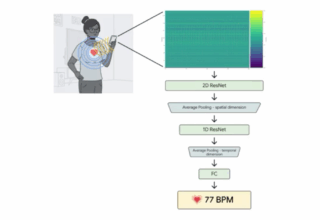Residents of the far southern settlement of Oban, on Stewart Island, claim sharks are being attracted by tour operators who offer the ultimate in thrillseeking
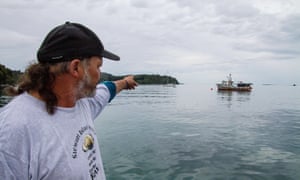
At the South Seas hotel on Oban waterfront, the conversation, as it so often does, hovers over a subject that swims just a few kilometres from the town’s shores: the great white shark.
“I love the sharks, they are magnificent creatures, but Jesus Christ we don’t know enough about them to be out there feeding them – it’s like fucking with a T-Rex with fins,” says Richard “Squizzy” Squires, a 62-year-old who runs La Loma fishing charters.
Squires’ wrath is not directed at the fish itself but at those who now make a living from allowing tourists to observe it in the water – the cage-diving operators of New Zealand’s Stewart Island, on which Oban lies.
A few years ago, after the introduction of cage diving in 2007, Squires says he was followed by a six-metre (20-foot) great white shark, which swam alongside his 12-metre boat for an hour and a half.
He has also had his boat attacked on two occasions, when a great white (he suspects it was the same one each time) lunged at the float attached to the stern of his craft.
“When [the operators] say they don’t follow boats, that’s a crock of shit,” says Squires.
“The last few years those sharks have shown an unhealthy interest in boats, and they are acting more aggressively. No other shark cage-diving operations operate this close to a tourist resort that is involved with the sea.”
Stewart Island – Rakiura – is New Zealand’s third largest island. It is located 30km south of Bluff, at the bottom of the South Island, across the often-turbulent Foveaux Strait, which takes an hour to cross by ferry and 20 minutes by light plane.
Around 85% of the island’s 1,570 square kilometres is protected as a national park, and only 380 people call it home – most involved with the seafood industry, or providing tourist services.
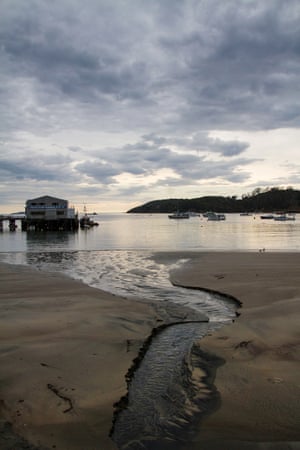
Sharing the seas with the human population is a significant population of great white sharks – estimates range between 59 and 120 animals. The great whites migrate here in late summer to early winter (peaking in autumn) to hunt baby seals, and until recently long-time islanders say they had a largely peaceful relationship with the giant fish, which became a protected species in New Zealand waters in 2007.
Phillip Smith, 72, a Rakiura Maori elder, says the sharks have “always been here”, but in his boyhood they were rarely seen, and largely kept to the north-west corner of the island, far from the modest township of Oban in Halfmoon Bay.
On the day we meet, Smith has just spotted an 3.5-metre great white swimming alongside his boat in Paterson Inlet, with a significant wound on its head.
“It is quite amazing the level of interaction between humans and sharks now. We see them all the time and not just one, sometimes three or four surrounding our boats,” he says.
“The sharks’ behaviour has changed since the cage diving started, no doubt about it. Now when they see a boat, or a float, the sharks associate it with food. We are being targeted, and it’s only a matter of time before they get someone.”
Just over seven years ago, two shark cagediving businesses began operating – unregulated – off Stewart Island, mostly dropping their anchor near Edward Island, 8km across the water from Oban.
Initially, many locals were excited about the new venture and the prospect of extra tourist dollars. At NZ$450-630 (US$290-410) a dive, the hope was that the high-end tourist market would spend their money in Oban, too.
But according to a significant number of Stewart Islanders who spend their days in or on the sea – paua (abalone) divers, fisherman and charter boat operators – when cage-diving began, the sharks’ behaviour changed dramatically.
Where once they were rarely seen, and shy of boats and humans, now every day there were reports flooding into “the office” – as South Seas hotel is known – of sharks following boats for hours on end, attacking floats and buoys, and swimming uncomfortably close to divers.
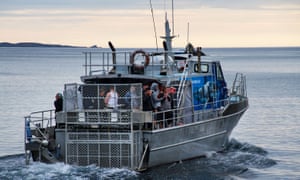
“It’s like Jaws anonymous out there,” says local man Alistair Faulkner, who crews on Squires fishing boat at weekends.
“They get together and go: which boat shall we target today? Where’s the next feed coming from? They’re smart, they know boats mean food now.”
The cage-diving operators deny that the sharks’ behaviour has changed.
Partly in response to vocal concern from Stewart Islanders, in December 2014 the Department of Conservation (DOC) introduced a permit system for the operators “aimed at reducing the risk of harm to great white sharks”.
On its website the DOC labels cage diving as an “ecotourism activity” that can help “develop a better understanding of these ancient and protected fish”.
One of the operators, Shark Dive NZ, echoes the ecotourism benefits but also on its website declares: “A cage encounter with a great white shark is the ultimate in adrenalin tourism.”
Although neither Shark Dive NZ nor the other operator, Shark Experience, would be interviewed for this story, under their permit agreement with DOC both are allowed to use the controversial method of “chumming” to attract sharks to the boat – a burley thrown into the sea made of fish oil, off-cuts and blood.
Both operators are also permitted to lure sharks to the boat by dangling large hooks into the sea baited with tuna.
Storm Stanley, chairman of PauaMac5 Incorporated, which represents Stewart Island paua divers, decided last year to take the DOC to court, seeking a declaration that it must consider the safety of other water users when granting a licence to cage-diving operations.
“I find the whole situation disturbing and heartbreaking,” says Stanley.
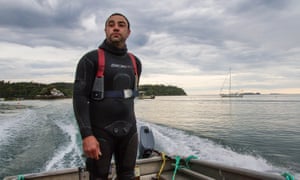
“These sharks are a protected creature and they are being teased for the thrill of adventure-seeking tourists. This is not ecotourism; the shark’s behaviour has undoubtedly changed.
“But these… operators are also dramatically changing the way of life on Stewart Island, and the livelihoods of locals who have made a living from, and respected the sea and its animals for generations.”
The Guardian tried multiple times to seek comment from the cage diving operators but was unsuccessful.
In 2013 the Discovery Channel came to Stewart Island to film the great white sharks for its popular Shark Week series. The crew described the Stewart Island shark population as “the most aggro sharks in the world” to their local minder Joanne Leask, she says.
The Discovery film crew has returned to the island every year since 2013, but for shorter and shorter spells each time, as their reception by the islanders has become increasingly hostile.
One islander who did not wish to be identified says the Discovery crew used the same techniques as the cage-diving operators to lure sharks to the boat, but on a much larger and more intensive scale.
“The waters around their boat turned red with blood, they were throwing so much chum overboard. They whipped the sharks into a frenzy and then called them serial killers and man-eaters. It was disgusting to watch.”
However, Leask, an islander for 30 years, says the Discovery film crew were respectful of the sharks. She is also supportive of cage-diving because she says it brings lucrative tourist dollars to the island.
“A lot of the local men – the old-time fisherman and paua divers – who are against it are very domineering,” says Leask.
“They stir up a lot of fury at the pub, but what they don’t realise is that a lot of people rely on the money cage shark tourists bring.”
Church Hill restaurant and Oyster bar co-owner Chris Sara moved to Stewart Island in 2012. On their first trip to the island the Discovery film crew ate at his restaurant, as have a significant number of tourists who have been cage -diving.
“One of the sad things about it is the people that come to do it don’t talk about it, they hide it, they are embarrassed,” says Sara.
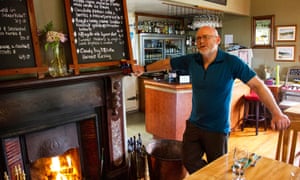
“They feel they are doing something wrong, and I think that’s sad for them because they have paid a lot of money for that experience.”
At the South Seas hotel, owner Helen Cave has made her views patently clear, displaying a stack of A4 pamphlets on her front counter calling for a halt to cage-diving.
“If this were happening in Auckland harbour there would be an uproar, but nobody listens to us down here because we’re so small and we are so far away.
“See out there, just there? That’s where they operate. That’s where the sharks go. Tourists treat them like Jaws, but we never had any problems before. We used to share the water together, peacefully.”
“The only people who support it on the island are those that have nothing to do with the water,” says Cave, who has lived on Stewart for more than 40 years.




